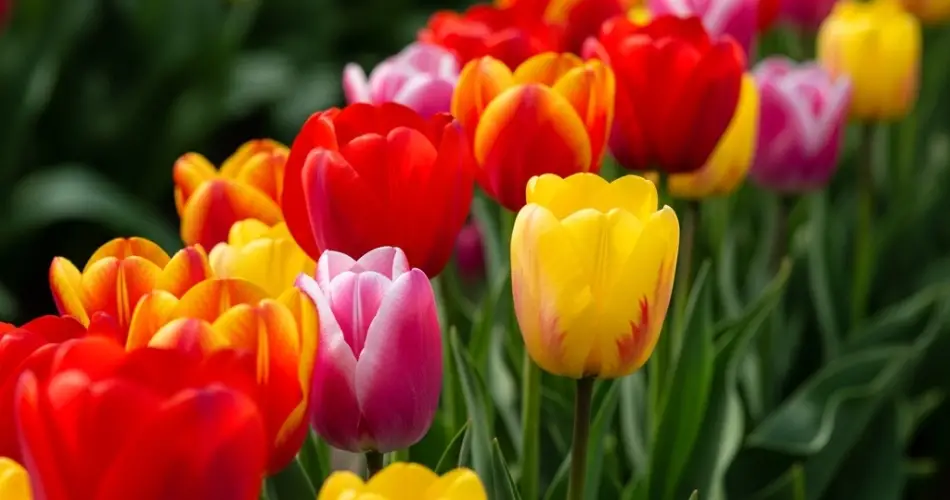Tulips are one of the most iconic and colorful flowers of spring, bringing elegance and charm to both garden beds and containers. While they’re relatively low-maintenance once established, proper care before, during, and after blooming is essential to keep tulips healthy and beautiful year after year.
Whether you’re growing tulips in decorative pots on your balcony or in flower beds in your backyard, this guide covers everything you need to know about tulip care—from planting to post-bloom maintenance.
1. Choosing the Right Tulip Varieties
Tulips come in hundreds of varieties, each with different colors, heights, and bloom times. Some types are better suited for container gardening, while others thrive in garden beds.
For pots, compact varieties such as:
-
Greigii tulips
-
Kaufmanniana tulips
-
Triumph tulips
For garden beds, consider:
-
Darwin hybrids (long stems and large blooms)
-
Parrot tulips (frilled and vibrant)
-
Single late tulips (for a late spring show)
Choose a mix of early, mid, and late-blooming varieties for a continuous splash of color throughout spring.
2. Planting Location and Timing
Tulip bulbs should be planted in the fall, about 6 to 8 weeks before the ground freezes. They require a period of cold dormancy to trigger spring flowering.
In garden beds:
-
Select a spot that gets at least 6 hours of sunlight daily.
-
Ensure soil is well-draining, as tulip bulbs rot easily in soggy soil.
In pots:
-
Use containers that are at least 10–12 inches deep.
-
Ensure pots have adequate drainage holes to prevent waterlogging.
-
Place the pots in a cold, sheltered outdoor spot for winter, such as a porch or garage.
3. Preparing the Soil
Tulips prefer light, sandy, or loamy soil with good drainage. The ideal soil pH is slightly acidic to neutral (6.0 to 7.0).
-
Mix in compost or aged manure before planting to boost fertility.
-
For pots, use a high-quality potting mix combined with some perlite or coarse sand to improve aeration.
Avoid heavy clay soils, or amend them with organic matter and sand to improve drainage.
4. How to Plant Tulip Bulbs
Depth: Plant bulbs about 6 to 8 inches deep, measuring from the base of the bulb.
Spacing:
-
In beds: Space bulbs about 4 to 6 inches apart.
-
In pots: Plant more densely but leave a little space between bulbs to allow growth.
Orientation: Place the bulb with the pointy end facing up and the flat root base down.
After planting, water thoroughly to help the bulbs settle into the soil and begin root development.
5. Winter Care
In cold climates, garden-bed tulips naturally receive the winter chill they need. If you live in a warmer region (zones 8–10), pre-chill bulbs in the refrigerator for 8–10 weeks before planting.
For potted tulips:
-
Keep containers outdoors in winter but shield them from extreme wet or freezing temperatures.
-
Cover pots with straw or move them to a sheltered area if needed.
Tulips need cold temperatures to develop strong flower stalks and bloom in spring.
6. Spring Growth and Flowering
As temperatures rise in spring, tulip shoots will emerge. When they appear:
-
Water lightly if the soil is dry, but avoid overwatering.
-
Once flower buds form, apply a balanced liquid fertilizer every 2–3 weeks to support blooming.
To keep the display looking tidy, remove any damaged or yellowing leaves and keep the area weed-free.
7. Post-Bloom Care
After tulips bloom, it’s important to deadhead the flowers by cutting off the spent blooms. This prevents the plant from using energy to produce seeds and instead directs it back to the bulb.
However, do not cut the foliage until it has fully yellowed and died back. The leaves continue to photosynthesize and feed the bulb for next year’s growth.
In pots, once the foliage dies, you can either:
-
Remove the bulbs, dry them, and store them in a cool, dry place until fall.
-
Discard the bulbs (especially in warm regions) and plant fresh ones next season.
8. Common Tulip Problems
Tulips are generally easy to grow, but they can occasionally face issues like:
-
Bulb rot: Usually caused by poor drainage. Ensure well-draining soil and containers.
-
Aphids or slugs: Remove by hand or use organic deterrents.
-
Failure to bloom: Often due to insufficient chilling, overcrowding, or depleted bulbs.
In many cases, tulips are grown as annuals, especially in warm climates or when planted in pots. Replanting fresh bulbs each fall can ensure a reliable display.
Final Thoughts
Tulips bring joy, color, and classic beauty to spring gardens. Whether planted in flower beds or decorative containers, proper care ensures a strong bloom and healthy plants. By choosing the right variety, planting in the fall, and tending to the bulbs year-round, you’ll enjoy a brilliant tulip display that returns each spring—or inspires a fresh start with new colors and combinations.



